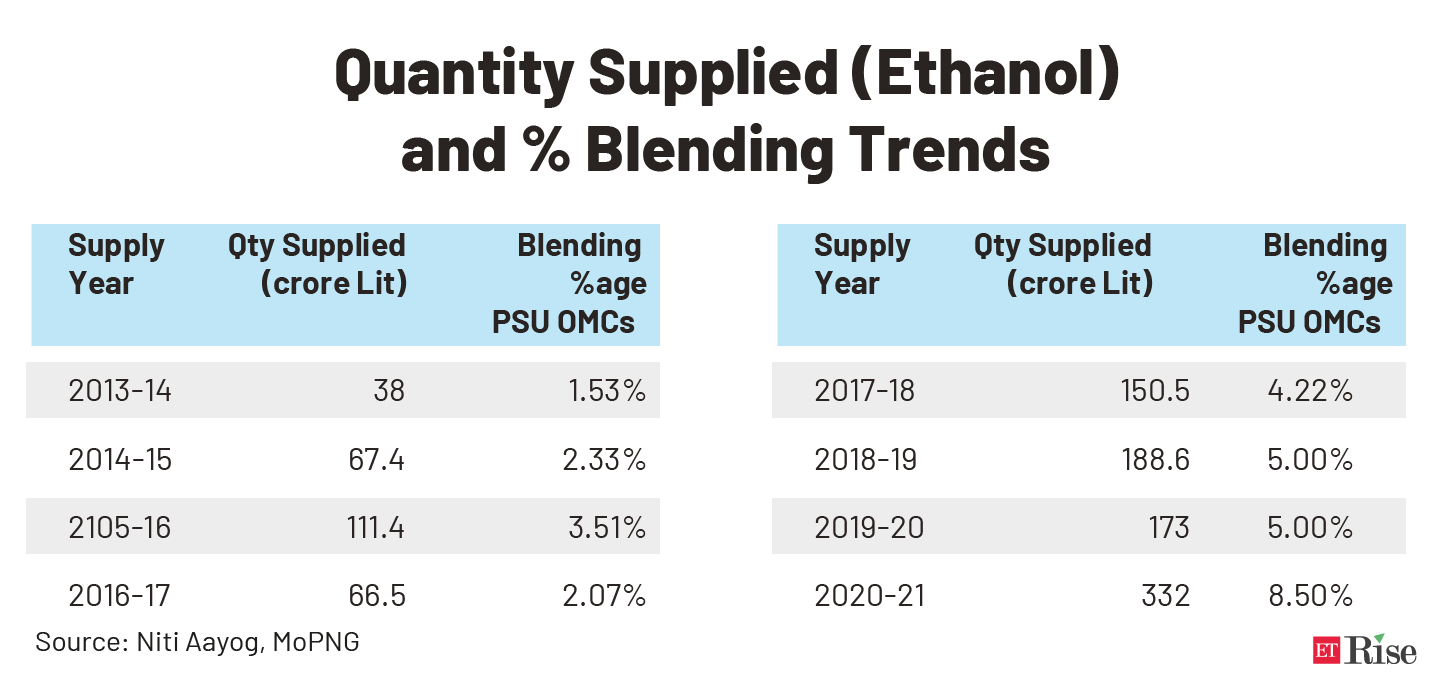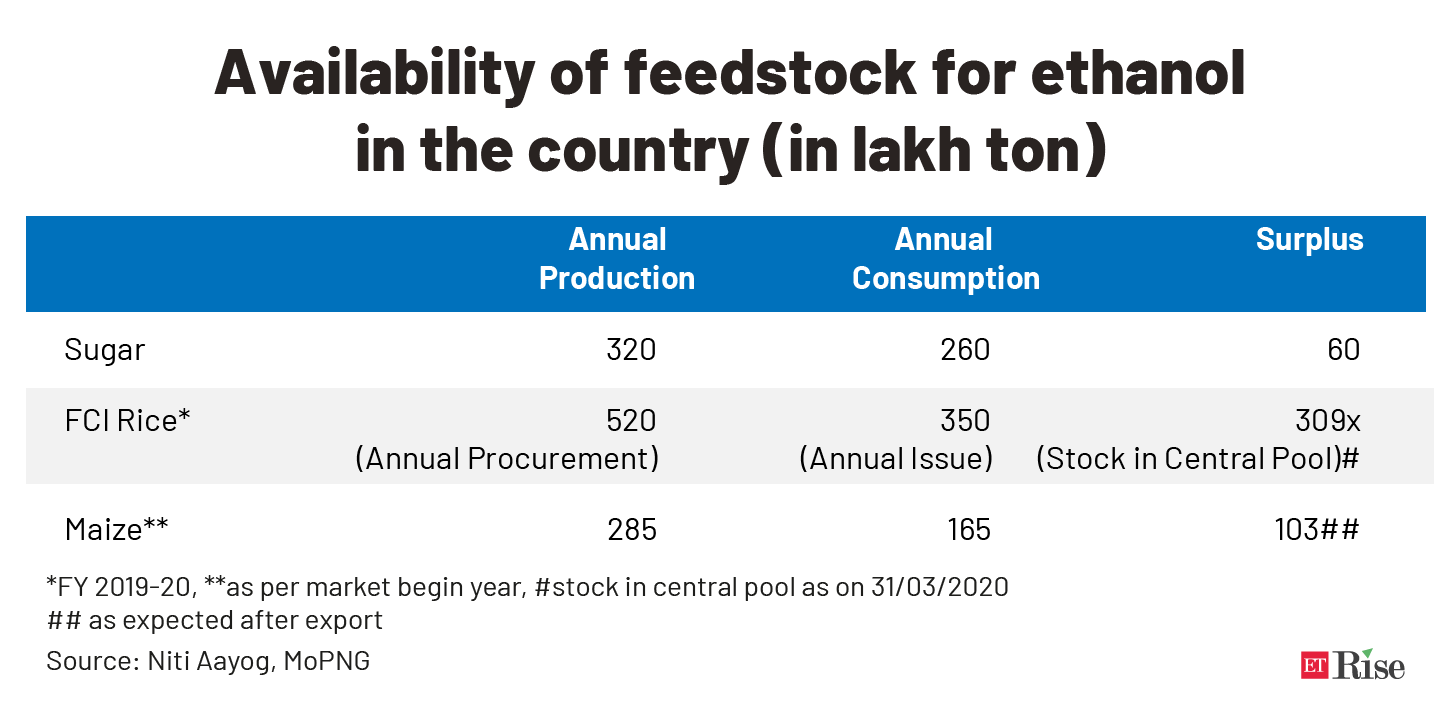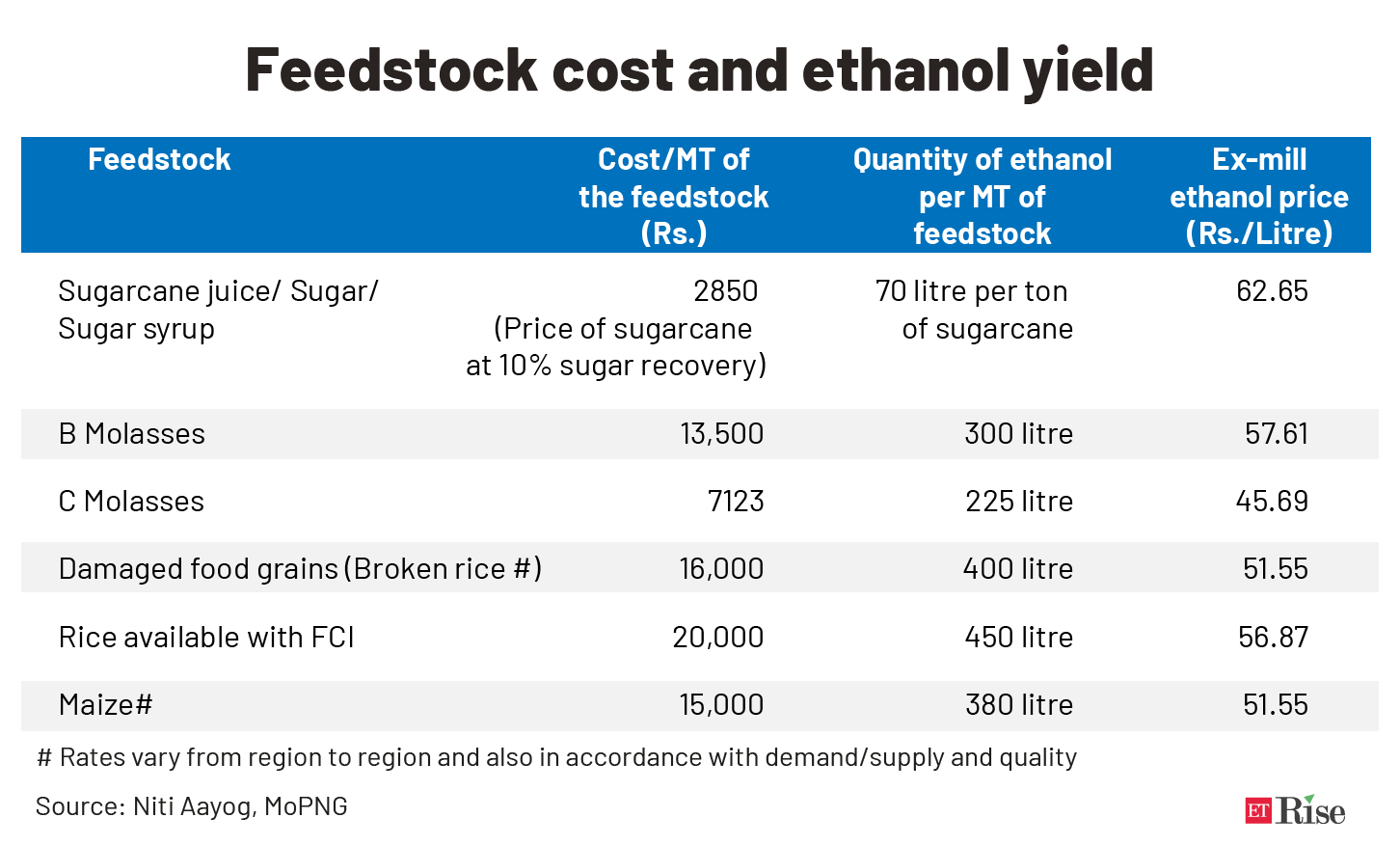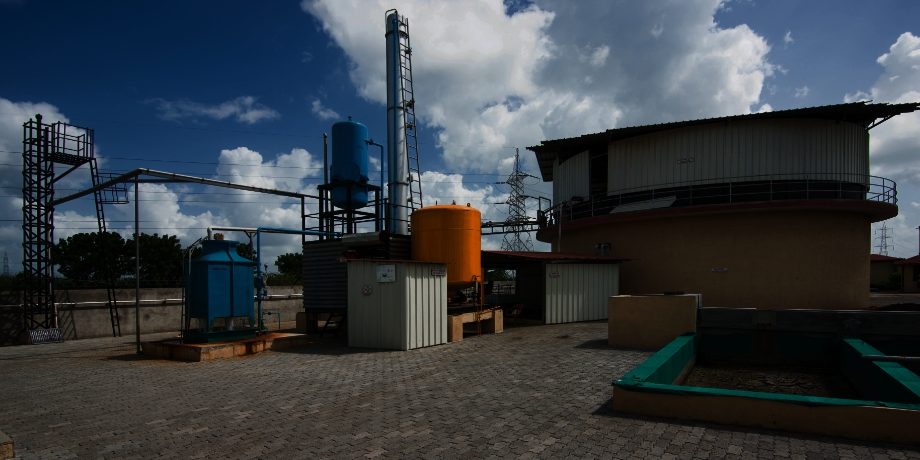The government’s recent move to extend the export restrictions on various types of sugar will help in keeping domestic prices in check, especially during the ongoing festive season. But it is going to affect the country’s ethanol blending target, set as part of the climate change goals.
The export barriers were imposed as poor rains led to lower sugarcane cultivation. This reduced the crop available to be diverted to make ethanol — the liquid is processed and blended with petrol to reduce vehicular emissions, cut fuel import bill, and give extra income to farmers, among others. The situation is a hurdle in the government’s plans to get more benefit by increasing the ethanol blend in fossil fuels, say industry observers.
India has a target to produce 4.5 million tonnes (mt) of ethanol from sugar this season. For this, the country would have to produce some 31 mt of sugarcane.
According to the Indian Sugar Mills Association (ISMA), the domestic production is likely to fall 8% to 33.7 million tonnes (mt) in the 2023-24 sugar marketing year (October-September). These figures don’t contain diversion towards ethanol. In the 2022-23 sugar marketing year, production was 32.8 mt after the diversion of 4.2 mt for ethanol.
Blending targets
As on August 31 of the 2022-23 ethanol supply year (December 1-November 31), ethanol blending with petrol (EBP) stood at 11.76% against the annual target of 12%. The target for 2023-24 is 15% and for 2024-25 is 20%. The 2022-23 target of 10% blending was achieved by June 2022, much ahead of the target date of November 2022.

A NITI Aayog report of 2021 said the country would need to make 13.5 billion litres of ethanol by 2025, a sixfold increase from the 2.7 billion litres in 2021. While 6.8 billion litres would be produced from sugarcane, 6.6 billion litres would come from food grains, it had said.
The report added that India’s net import of petroleum was 185 million tonnes (mt) at a cost of $551 billion in 2020-21. A successful ethanol blending programme can save the country about $4 billion per annum or about Rs 30,000 crore.
“Meeting the ambitious ethanol blending target of 20% by 2025 is indeed a substantial challenge,” says Gaurav Kedia, Chairman, Indian Biogas Association (IBA). “Our estimate is that we will need 1,400 crore litres of ethanol. This means there has to be a significant jump in production. Also, the reliance on the sugar industry for a large portion of ethanol adds to the complexity.”
The national ethanol production capacity reached 1,244 crore litres in 2023, of which over 75% is molasses-based and remaining grain-based production capacity.
Former finance secretary Subhash Chandra Garg says the target of 20% ethanol in petrol by 2025 is built on a shaky foundation as it is tied to the country having surplus sugar, rice, and wheat production. “When there is pressure on production of these commodities, as is the case now, on account of any factor, natural or otherwise, the supply surplus for ethanol gets reduced.”
As the government prefers ethanol production over exports, it reacts by reducing the exportable quantities. But the going will get tougher when there aren’t enough supplies of sugar, rice or wheat for ethanol production even after export control, he says.
“India must abandon any target-based approach to push ethanol blending in petrol, like E20 (20% ethanol) by 2025. A price incentive-based strategy is good enough to divert surplus supplies for ethanol production,” adds Garg, who has served as the economic affairs secretary in the Modi government.

Weak monsoons
India witnessed the weakest monsoon since 2018 this year. It has cast a cloud over sugarcane harvest in major producers such as Maharashtra and Karnataka. Sugar prices have gone up 5-8% y-o-y in the July-September quarter of FY24, according to trade estimates.
Uppal Shah, Co-founder and CEO, AgriMandi.live Research, estimates the output in the current season at 29.8 mt, after factoring in 4-4.2 mt of sugar being diverted for ethanol production. The carried forward stock from 2022-23 sugar season (SS) is 5.7 mt, pushing up the availability to 35.5 mt.
“It’s important that there is enough sugar in the country to meet the ethanol blending programme (EBP) and the domestic demand. Export curbs at this point are important to meet domestic requirements. We will have a better understanding of the cane crop and sugar availability in January 2024. The government can weigh options and tweak the policy accordingly then,” says Shah.
But the chances of meeting 2023-24’s blending goals seem unlikely. Kishan Karunakaran, Founder and CEO of Buyofuel, says the only hope is that the Northeast monsoon brings enough rains to increase the end-of-the-season sugar stocks. “This will give India a chance to meet its blending mandate by 2024.”
Drop in per-hectare sugarcane yield
Changing climatic patterns are giving another headache to policymakers and industry stakeholders: a drop in per-hectare sugarcane yield. According to a Reuters report, farmers in India have reported a 15% drop in cane yield.
Climate change is also leading to a deficiency in sucrose content in the crop; ethanol yield is higher when sucrose content is high.
Both these factors have impacted sugar production and are a significant challenge for the domestic sugar industry, says experts.

“A drop in per-hectare cane yield and a reduction in sucrose content can have a significant impact on sugar production. It might be attributed to various factors like climate conditions, nutrient availability, soil health, pest infestations or changes in agricultural practices. If these trends persist, they could pose challenges for the sugar industry and related sectors. There are already concerns over agricultural practices like monocropping or conversion of land to sugarcane production,” says Kedia.
Lowering yields can lead to more land being dedicated for sugarcane production, thus lowering land availability for other crops, he adds.
Market dynamics
The fuel blending plan faces a roadblock as the government hasn’t yet announced the ethanol procurement price for ethanol supply year (ESY) 2022-23. Sugar mills wait for this announcement to strategise their product mix — much ethanol and sugar they should produce to maximise revenue. Even a slight increase in domestic sugar prices can push the mills to produce more sugar and less ethanol.
The fall in cane production in Karnataka and Maharashtra narrows the time sugar mills have for crushing operations. Shah explains this means ethanol production would get less priority in the revenue mix. “The industry needs ethanol price direction from the government. We request the government to announce ethanol prices for the current year without any delay to give sugar mills proper direction,” he adds.
The government had raised the price of ethanol extracted from sugarcane to Rs 65.60 a litre from Rs 63.45 per litre for the supply year that began in December 2022. Sugar industry sources say they want the new prices to be Rs 5-6 more per litre.

Should focus now shift to rice and maize?
The ethanol blending plan will also have to get ready to bypass or face a more crucial problem: one that involves shifting the raw materials from cane to food crops. Sugar-based ethanol dominates biofuel production in India.
Food-based plants provide the majority of first-generation biofuels (1GB). This, critics say, will impact the food security in India. Second-generation biofuels (2GB) use non-food items such as straw, bagasse, forest residues. But their commercial-scale production is limited at present. Third-generation (3GB) biofuels are algae-based — a non-food, high-yield source. These are only in the development stage. The fourth-generation intends to use photobiological solar fuels and electro fuels.
While India is seeing growth of 2G ethanol projects, a shift towards using rice and maize for ethanol production due to the lower availability of sugarcane could indeed have implications for food security, say experts and industry stakeholders.
“It might affect the availability and prices of the staple food crops. Striking the right balance between fuel production and food security is crucial. The government needs to carefully manage policies to ensure sustainable agricultural practices, promote alternative crops for ethanol, and safeguard food supplies. It is a complex juggling act to meet energy needs without compromising on essential food resources,” says Kedia of IBA.



